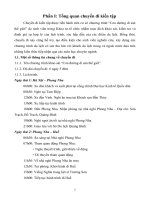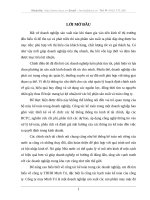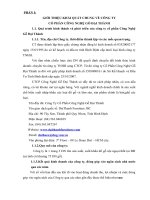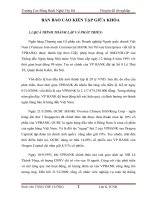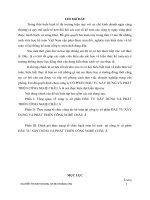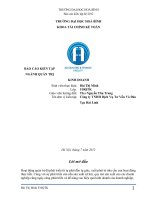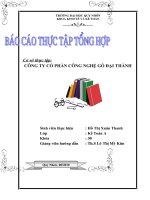báo cáo kiến tập INTERNSHIP REPORT
Bạn đang xem bản rút gọn của tài liệu. Xem và tải ngay bản đầy đủ của tài liệu tại đây (433.92 KB, 30 trang )
THE NATIONAL ECONOMICS UNIVERSITY
ADVANCED EDUCATIONAL PROGRAM
INTERNSHIP REPORT
At Hoa Binh Corporation
Student’s name: Đặng Hoài Nam
Class: Advanced Accounting
Intake: 53
Supervisor:
Hanoi - 2014
TABLE OF CONTENTS
ACKNOWLEDGEMENTS
ABBREVIATION
LIST OF TABLES
LIST OF FIGURES
PREFACE
CHAPTER 1:
1
1.1
1
1.2
4
1.3
5
1.4
6
CHAPTER 2:
7
2.1
8
2.2
10
2.3
14
CHAPTER 3:
15
3.1
16
3.2
27
3.3
28
CONCLUSION………………………………………………………………… 30
REFERENCES
APPENDICES (if any)
Supervisor: Dang Hoai Nam – Class: Advanced Accounting
2
ABBREVIATION
HO Head Office
SBV State Bank of Vietnam
VIDPB VID Public Bank
Supervisor: Dang Hoai Nam – Class: Advanced Accounting
3
LIST OF TABLES
Table 1.1:
16
Table 2.1:
46
Table 2.2:
47
Table 3.1:
67
Table 3.2:
72
Chú ý:
- Chữ số thứ nhất chỉ tên chương
- Chữ số thứ 2 chỉ thứ tự bảng biểu trong mỗi chương
- Trong mỗi bảng biểu ghi rõ nguồn số liệu từ đâu
Supervisor: Dang Hoai Nam – Class: Advanced Accounting
4
LIST OF FIGURES
Figure 1.1:
15
Figure 1.2:
20
Supervisor: Dang Hoai Nam – Class: Advanced Accounting
5
PREFACE
(Present introduction and structure of the Internship Report)
Supervisor: Dang Hoai Nam – Class: Advanced Accounting
6
Chapter 1: OVERVIEW OF ABC FIRM (3 points)
1.1. Establishment and Development of ABC Firm (1 point)
(In this part, present some background information of the firm, establishment and
development; some historical points of the firm during establishment and development;
some achievements of the firms and others)
Hoa Binh Construction & Real Estate Corporation (Hoa Binh) was founded
on 27
th
September 1987 on the foundation of Hoa Binh Construction Office, started to
operate in designing and construction of a private residential projects. Established in “Doi
Moi” economic reformation period, Hoa Binh continually made great efforts to overcome
difficulties and reaffirm its capability. Hoa Binh has grown into a top leading construction
company in Vietnam and well-known amongs foreign contractors with “Reach the peaks
peacefully” impressive slogan. Hoa Binh has developed a decisive and dynamic
management team together with 6,000 employees who have always devoted their technical
abilities, creativity and their utmost effort to the company. Hoa Binh is also the only
construction company in the South to be selected to participate in “VIETNAM VALUE
PROGRAM” and achieve many valuable domestic and international awards. In recently,
Hoa Binh proudly contributed to completing 80 high – rise projects and is currently
carrying out approximately 50 projects all around the country. The following part will
briefly introduce the company’s development process from 2005 to now – reaching the
peaks.
In 2006, Hoa Binh was officially listed on Ho Chi Minh City Stock Exchange and became
the first general contractor participate in Vietnam Stock market. This remarkable event
created opportunities for Hoa Binh to strengthen its position.
In 2007, Hoa Binh increased capital through the stock exchange market, its investment
expansion to the real estate field, as well as its cooperation opening to many strategic
partners in the construction and real estate fields such as Chip Eng Seng Group, Citadel
Supervisor: Dang Hoai Nam – Class: Advanced Accounting
7
Investment Fund (Hong Kong Branch), HCMC Branch of Petro Vietnam Finance
Company. Also Hoa Binh has become a reliable partner for many big companies in the
field of construction and real estate, especially for foreign investors such as KTOM joint
venture (a conglomeration of four big Japanese construction groups: Kajima, Taisei,
Obayashi, and Maeda), Sino Pacific Company, Indochina Resort, Posco Engineering &
Construction Company, Phu My Hung Joint Venture, and so on. With these utmost efforts,
Hoa Binh received many awards and prestigious titles, such as Vietnam Gold Star, Strong
Brand Name in construction industry and Top Ten Vietnamese Brand Name.
In 2008, the financial crisis and the subsequent global economic recession had a big impact
on Hoa Binh’s business operations. Nevertheless, in such a context Hoa Binh learnt lessons
from experiences in risk management, financial management and investment projects
management, minimize disruptive events and assure the sustainable development of the
Corporation. Hoa Binh performed many large-scale projects such as Hanh Phuc
International Women and Children Hospital (Binh Duong), Phu My Apartment Buildings
(District 7, HCMC), Nam Long (District 7, HCMC), Can Tho International Airport
Terminal, Truong Tho Apartment, Kumho Asiana Plaza (HCMC), Keangnam Hanoi
Landmark Tower, CRR & CR8 the Crescent Pool…
In 2009, Hoa Binh has also started implementing the ERP management software and the
5S program to both parent company and all subsidiaries. Major projects in 2009: Saigon
Pearl – Development (HCMC), The Kenton Residences Blocks G & H (Nha Be – HCMC),
Mipec Tower (Hanoi), Habico (Hanoi), Green Hotel (Kien Giang), Vincom – Area B
(HCMC). Hoa Binh was the only contractor to be selected participating in Vietnam Value
program and awarded Vietnam Gold Star, “Social Responsibility”, International Star
Award for Leadership in Quality Management, Top 500 Vietnamese Private Enterprises
and many other awards.
In 2010, exceeding over 2000 enterprises, Hoa Binh once again honorably achieved the
“Vietnam Value” award for second time, Vietnam Gold Cup for Construction Quality
awarded to its 3 projects. Besides, Hoa Binh rapid growth rate of revenue and profit, the
company always orients to an ideal working environment. Board of Management
constantly takes care of employees by organizing travel trips in Da Lat, Nha Trang, Mui
Ne.
In 2011, there is fluctuation of economy situation in the world as well as in the country and
gives impacts on Hoa Binh business activities. By experiences and appropriate strategies,
Hoa Binh achieves many successes. It successfully implements OHSAS 18001:2007 and
ISO 14001:2004 systems granted by British Standard Institute. Also, Hoa Binh applies
CONQUAS international standard system developed by the Building and Construction
Authority of Singapore to assess project quality, B.I.M (Building Information Modeling)
solution in design, construction management, and Portal Office software. According to
logic and professional management working to international standard, human resources
and service quality will be improved more and more.
In 2012: Hoa Binh celebrated the 25th anniversary and received the 3rd Class Labor
Medal, the Chairman cum CEO, Mr. Le Viet Hai proudly received the Prime Minister’s
Award, and the company members honorably received the Award Certificate of Merit by
Supervisor: Dang Hoai Nam – Class: Advanced Accounting
8
Ho Chi Minh People’s Committee. Hoa Binh is proudly the only Southern Construction
Enterprise continues to receive the 3rd Vietnam Value in the row and it is one of 25
entrepreneurs to receive this honor certificate; Hoa Binh is one of two Construction
Enterprises in HCMC honorably received the Certificate of Merit by Ministry of Labor –
War Invalids and Social Affairs.
The Company also successfully expands to Industrial and Infrastructure industry with 8
projects which total value is more than 1,700 billion dong. Besides that, Hoa Binh is fast –
growing in North and Middle as well as the other provinces market.
In 2012, Hoa Binh accomplished the last BI subsystem (Business Intelligent) of ERP, and
Hoa Binh is also the 3rd company successfully established the Business Intelligent in the
country.
1.2. Characteristics of the Business Operation of ABC Firm (1 point)
1.2.1. Functions and Responsibilities
The corporate has three main purpose and functions are the following.
- Provide client with the best products and services in the most convenient and
quickest way in the construction and real estate industry.
- Set up the most efficient work environment in order to comprehensively develop
each employee’s talent.
- Completely satisfy all staffs’ needs and dreams, while bringing appropriate profits
to the Corporation and satisfactory benefits to the shareholders and contribute as
much as possible to the country and society at the same time.
In addition to determining functions, the corporate identifies its responsibilities in three
sections: social, shareholder and employee responsibility. The following part is the details
of such responsibilities:
- Social responsibility:
o Comply with Vietnamese legal regulations on labor force. Respect the
international conventions cited in part II of SA 8000:2001 and the related
explanations.
o Frequently express concern to introduce upgrading of working conditions to
our staff and workers and environment protection for the community.
o Release all documents on the Social Responsibility Policy to all staff and
employees, including our subsidiaries, subcontractors, and suppliers, to help
them understand and support the implementation of our policies.
- Shareholder responsibility:
o The Board of Directors focuses on developing a strong management team in
order to secure and ensure transparency and responsibility while carrying
out the tasks of the Executive Board of Management and managers, which
in turn contribute to building the shareholders’, investors’ and relevant
parties’ confidence
- Employee responsibility:
Supervisor: Dang Hoai Nam – Class: Advanced Accounting
9
o The Corporation has prepared and issued documents related to staff and
employees’ responsibilities regarding the Corporation and initiated training
and orientation courses. This is communicated via such media as its internal
network, website, bulletins and department meetings to guide all staff and
employees to fulfill the Corporation’s mission and policies. Such policies
are focused on strengthening a sense of discipline to work in a positive
manner, and on encouraging persistence, honesty, integrity and
responsibility regarding the community, ethics, and professional conscience.
1.2.2. Features of the Business Operation
The Company’s current principal activities are to provide industrial and civil construction
services; surface levelling; construction consulting services; manufacture and trade of
construction materials, interior decoration products; house renovation and interior
decoration services; and to trade real estate.
1.2.3. Process of Main Activities of Company
The main activity of the company is construction which is divided into 4 phases: signing
contract, planning, operation and handover.
Supervisor: Dang Hoai Nam – Class: Advanced Accounting
10
Supervisor: Dang Hoai Nam – Class: Advanced Accounting
11
Phase 1: In the signing contract phase, in order to have a contract, planning and engineer
department have to prepare a profile to compete with other contractors. If the owner
choose the company, the BOD signs the contract so they have the authority to perform
construction.
Phase 2: The Board of Directors then hold a meeting with other departments to plan and
prepare estimated fund for the project. The general plan consist of categories: choosing
sub-contractors, material plan, human resources plan, machines and equipment, safety
environment and finance.
Phase 3: The BOD confirm the plans and distribute to involved departments. A project
groups is established and perform construction under the monitoring of a third party
chosen by the owner.
Phase 4: In the handover phase, the company conduct a trial a complete test to verify the
completion of the construction. If the test is confirmed, the company will hand over the
building to the owner. Base on the time determined in the contract, the company will
perform warranty regularly.
1.3. Organizational Structure of ABC Firm (0.5 point)
(Present the organizational structure of the firm by the figure and then state the functions
and responsibilities of departments inside the firm)
Figure
Explanation:
1. Supervisory Board: On the basis of its extensive written and verbal reporting by the
Managing Board issued promptly and in the necessary detail, the Supervisory
Board supported the Board of Directors in its monitored the Board of Directors in
its management of business over the fiscal year. Basically, Supervisory Board has
the authority to keep informed at all times of the intended business policy and other
fundamental issues and report to Shareholder Meeting.
2. Board of Directors: The members of the Board of Directors which manages the
company, have equal standing. They and the CEO are represented on the Board
with areas of responsibility that include their individual central functions. The areas
of responsibility for the central functions are divided among the 14 members of the
Board of Directors.
3. Advisory Board: the Advisory Board support the Board of Directors by its advisory
functions.
4. The Chief Executive Officer (“CEO”) is responsible for leading the development
and execution of the Company’s long term strategy with a view to creating
shareholder value. The CEO’s leadership role also entails being ultimately
responsible for all day-to-day management decisions and for implementing the
Company’s long and short term plans. The CEO acts as a direct liaison between the
Board and management of the Company and communicates to the Board on behalf
Supervisor: Dang Hoai Nam – Class: Advanced Accounting
12
of management. The CEO also communicates on behalf of the Company to
shareholders, employees, Government authorities, other stakeholders and the
public.
5. Board of Assistants and Secretaries perform routine clerical and administrative
duties. They organize files, draft messages, schedule appointments for board of
directors, and support other departments.
6. The Administration Groups consists of four departments:
- Administration Department design and organize the overall work performance of
the company and manage of office environment. It also has responsibility of
gathering, adapting, storing and distributing information within the company.
- QA Department has the duty to give information of the company and answers
according to staff’s questions. They are required to answers on time.
- Security Department provides and ensures an safe working environment for
employees.
- Training Department prepares courses for new employees or increase human
resources quality in the company.
7. Technical – Industry Group consists of four departments:
- R&D – Information Dept.’s primary function is to conduct research for new
materials and develop new solution in construction.
- ERP Department designs and implements ERP systems in the company.
- IT Department is responsible for the architecture, hardware, software and
networking of computers in the company. IT professionals working in this
department perform a number of duties to ensure that employees have full access to
the computer systems.
- BIM Department creates collaboration through the entire life-cycle of assets,
underpinned by the creation, collation and exchange of shared 3D models and
intelligent, structured data attached to them. In short, they models building and
others assets in 3D.
8. The Business Group consist of three departments. The main responsibilities of the
group are to purchase, store and deliver equipment in need. They are divided into
equipment types: materials departments, machinery equipment departments.
9. Operation Group provide and ensure a safe and efficient environment in each
construction project. They are technical department, maintenance department,
surveyor department, HSE department.
10. Investment Groups are subsidiary companies which specialize in producing
productions and material in construction industry. The company are now have
major share in five companies.
11. Accounting Department maintains accounting information for finance department
plans and control the funds. They also prepare interim and annual financial
statements and managing materials and equipment.
12. Human Resource Department is responsible for hiring members of staff; this will
involve attracting employees, keeping them in their positions and ensuring that they
perform as expectation.
13. Contract and Quantity Surveyor Department are responsible in applying contracts
and concern with construction costs which includes cost planning and commercial
management during the entire life cycle of the project from inception to
completion.
Supervisor: Dang Hoai Nam – Class: Advanced Accounting
13
14. The main functions of the Internal Audit Department are interacting with the
Company’s governance bodies, the Internal Audit commission and the Company’s
external auditors, auditors and affiliates; assessing the effectiveness of the risk
management system and developing recommendations to improve the risk
management processes; consulting the Company’s management on the matters
concerning its effectiveness.
15. Marketing Department's duties are almost always tied to increase company images
and reputation by guiding the company on which pricing, promotional strategies to
use.
16. Three representative offices were established to conduct marketing and other non-
transactional operations in Hanoi, Danang and Kuala Lumpur.
1.4. Financial Position and Operational Results of the ABC Firm
Table 1.1: Financial position of Hoa Binh company in 2011, 2012, 2013
ITEM
(BILLION VND)
2011 2012 2013 2012 vs
2011
2013 vs
2012
Short term assets 2,550 3,760 3,986 0.47 0.06
Long term assets 735 820 741 0.12 -0.1
Total assets 3,285 4,580 4,727 0.39 0.03
Short term liabilities 2,472 3,560 3,679 0.04 0.03
Long term liabilities 85 241 91 1.84 -0.62
Total liabilities 2,557 3,801 3,770 0.49 -0.01
Owners’ equity 721 771 950 0.07 0.23
Interest of the minority’s
shareholders
6 8 7 0.33 -0.12
Total Capital 3,285 4,580 4,727 0.39 0.03
Table 1.1 shows some noticeable items that have significant changes from 2011 to 2013.
The company has a huge increase in total assets by 0.39 times, with 0.47 increases in short
term assets, and 0.12 times in long term assets. There is such significant changes because
the company has successfully expanded the market share in the industrial and
infrastructure construction field. In the past year, there were 7 industrial and infrastructure
construction projects signed with total contract value of more than 1,700 billion Vietnam
dongs. Revenue of this segment in 2012 accounted for 18.50% against the year of 2011
when there was almost no any percentage. The majority of funds for the asset increase was
from loan, which increased 1.84 times in 2012 comparing to 2011. In the following year,
the contribution of the Construction and Real Estate sectors to GDP growth was at the
lowest level over the past years though the growing rate of these sectors since 2012 has
been improved. In that situation, the company stopped purchasing assets, especially long
term assets which reduced 0.1 times comparing to 2012. Major of long term liabilities was
paid on times so there was a decrease by 0.62 times.
Table 1.2: Income statement of Hoa Binh company in 2011, 2912, 2013
ITEM
(Billion VND)
2011 2012 2013 2012 vs
2011
2013 vs
2012
Net revenue 3,055 4,065 3,432 0.33 -0.15
Supervisor: Dang Hoai Nam – Class: Advanced Accounting
14
Gross profit 420 378 313 -0.1 -0.18
Operating profit 174 103 60 -0.26 -0.42
Financial income 33 36 41 0.09 0.13
Financial expenses 150 164 112 0.09 -0.32
Profit before tax 185 157 44 -0.16 -0.72
Net profit after tax 150 131 24 -0.12 -0.82
Net profit after tax attribute to equity
holders of the company
149 132 26 -0.12 -0.81
In 2012 comparing to 2011, the increase of goods sold makes gross profit decreased. If the
gross profit of 2011 was 13.7%, it fell to 9.3% in 2012. The main reason is that the
construction of residential buildings, hotels and resorts was delayed or extended leading to
increasing costs. On the contracting aspect, the company may claim for compensation of
damages. Certain other causes also accounted, such as the real estate market is in hard
situation, the investors slow down the progress that increases the contractor’s costs, the
high revenue of nominal subcontractor, the bid price is low down due to drastic
competition.
In 2013 comparing to 2012, net revenue decrease only 0.15 times comparing to a decrease
by 0.82 times in net profit after tax. It is because The Construction and Real Estate Sectors
in 2013 endured many hardships such as fierce competition, conservative declination in
housing price, the obstacle in term of credit for construction and real estate due to
unrecovered trust of market and the Government’s limited support policies.
Chapter 2: ACCOUNTING DEPARTMENT AND ACCOUNTING
SYSTEM AT ABC FIRM (4 points)
2.1. Accounting Department of the ABC Firm (1 point)
2.1.1 Diagram of accounting organizational structure
Supervisor: Dang Hoai Nam – Class: Advanced Accounting
15
To manage the business operation effectively, any company need to utilize a lot of
management method, of which accounting system is highly considered. Accounting
system will provide accurate and immediate the fluctuation of asset as well as the
manufacturing or producing process. Therefore, the organization in accounting
department and accounting system is necessary to be attentive.
Accounting is professional that related to recording, summarizing, analysis and
classifying business transactions by scientific method – In accordant with
economics scale and specialization of the company. Accounting help to develop and
support to management and operations.
In the definition of company, there are total 14 functions divided into 34 sub
functions. All of them are categories by 3 level of important in each functions, they
are: main functions, decision functions and support/attend functions. To clarify the
functions of accounting department, I will only present main and decision functions
as below:
- Control cost and expense of projects.
- Perform payment procedure
- Managing value of short and long term assets in accounting books.
- Financial planning (update information, conduct financial statements and tax
reports)
- Accounting management
- Supervise and perform accounting system in all components (Mother
company, subsidiary company, projects, construction)
2.2. Accounting System Applied at the ABC Firm (1.5 points)
2.2.1. The Main Accounting Policies Adopted
Supervisor: Dang Hoai Nam – Class: Advanced Accounting
16
(In this part, state some main accounting policies employed by the ABC Firm such as
Accounting System, currency, accounting period, VAT approaches, accounting for
inventory, revenue recognition, depreciation method, fixed assets recognition, foreign
exchanges and others)
The company applies corporate accounting system promulgated by Decision 15/2006/QD-
BTC dated on 20/3/2006 of Minister of Finance. Currency used for recording is Vietnam
dong (VND). Fiscal year begins on 1st January and ends on 31st December each year.
Method of VAT calculation applied is VAT deduction method. About inventory
accounting, inventories are recorded at original cost that includes cost of purchase, cost of
conversion and other costs incurring to make inventories available at current location and
status. Additionally, the company applies perpetual inventory method for recording and
First in-First out for calculating value of inventory. Periodically, in case net realizable
value is lower than original cost, inventory is stated at net realizable value. Moreover,
provision for obsolete inventories made at the end of year is the greater amount of original
cost compared to net realizable cost.
Depreciation calculation at PMC is applied as follows: Fixed assets are recorded at original
cost; during useful life fixed assets are recorded with original cost, accumulated
depreciation and carrying amount; depreciation is calculated on a straight-line method.
Standard method is used for recording foreign currency.
Finally, the company classifies Cash and cash equivalents into cash on hand, cash in bank,
short-term investments that mature below three months with high liquidation, availability
of exchange to determinable amount and medium risk of exchanging to cash.
2.2.2. Accounting documentations & vouchers
2.2.2.1 Vouchers regulations
Voucher system applied at Hoa Binh company promulgated by Law on accounting No.
03/2003/QH11 dated 17 June 2003 and Government Decree No.129/2004/ND-CP dated 31
May 2004.
2.2.2.2 Organization and management of accounting vouchers
- Make, receive, handle vouchers
- General accountants and chief accountant check and sign voucher or present manager for
signing
- Classify, sort vouchers, make entries and post to ledger
- Preserve and store vouchers
- Example of vouchers in payroll system
+ Employee changes
+ New employee data
+ Timesheets
+ Lump sum contract
+ Payroll register
+ Tax report
+ Payroll report
- Example of fixed-asset vouchers
+ Minutes of receiving fixed asset
+ Minutes of disposing fixed asset
Supervisor: Dang Hoai Nam – Class: Advanced Accounting
17
+ Minutes of receiving completely repaired fixed asset
+ Minutes of revaluating fixed asset
+ Tables of allocating depreciation of machinery and equipment for construction
+ Tables of depreciation of fixed asset used in company overall
2.2.3. Accounts in Accounting System
(State accounting system applied, the way to manage and open accounts such as accounts
of inventories, revenue, expenses, receivables, payables and others)
Account system of PMC applies the system catalog accounts attached to the Decision
No.15/2006/QD- dated March 20 2006 of Minister of Finance
In addition to common accounts, the company also open sub-accounts to meet
management requirements and facilitate accounting work.
For example:
- PMC uses following sub-accounts of Ac 152 for recording materials
+ Ac 1521: Main materials
+ Ac 1522: Auxiliary materials
+ Ac 1523: Fuel
+ Ac 1524: Replacing components
+ Ac 1526: Construction instruments
+ Ac 1528: Other materials
- The company uses Account 623 for recording cost of construction engine with following
sub-accounts
+Ac 6231: Labor costs
+Ac 6232: Cost of materials
+Ac 6233: Cost of manufacturing tools
+Ac 6234: Depreciation of construction engine
+Ac 6237: Services from Outside
+Ac 6238: Other cash expenses
2.2.4. Accounting Books
(State the process of accounting books: present figure and explain briefly of the process of
accounting book adopted such as Nhat ky Chung tu, Chung tu ghi so, Nhat ky chung, &
Nhat ky So cai; or other accepted accounting book process).
- The accounting book system of the company is in compliance with the Accounting
Law ,Decree No.129/2004/ND-CP of the Government dated May 31st 2005.
- Hoa Binh company applies General Journal form to record all transactions and use
accounting software for recording. Once data enters recording process, computer
automatically process and present accounting books and statements to provide to the users.
- General Journal form includes following kinds of books:
+ General Journal
+ Special Journal
+ General Ledger
+ Detailed accounting tickets and subsidiary ledger
Supervisor: Dang Hoai Nam – Class: Advanced Accounting
18
- Sequence of recording:
+ Everyday accountants initially make entries to general journal based on checked original
vouchers and simultaneously record into detailed accounting tickets and subsidiary ledgers.
Then based on entries in general journal accountants post to general ledger.
+ The company uses special journal for cash receipts and cash disbursements. Everyday
based on original vouchers entries are made to relevant special journal. Monthly the
information in special journal is posted to general ledger.
+ At the end of period (3 months), general detailed reports are made based on detailed
accounting tickets and subsidiary ledgers. Together trial balance is made based on general
ledgers.
+ After reconciling between trial balance and general detailed reports, accountants prepare
financial statements.
Diagram 2.1
Supervisor: Dang Hoai Nam – Class: Advanced Accounting
19
2.2.5. Accounting report system
(State the period of financial statement preparation, whom to send the reports,
responsibilities of forming financial statements, management reports and others).
- Accounting reporting system is in compliance with the Decision 15/2006/QD dated
20/3/2006 of the Minister of Finance. The financial statements are prepared and disclosed
in accordance with Vietnamese accounting standard.
- The financial statements include 4 categories:
+ Balance sheet
+ Income statement
+Statement of cash flows
+ Notes to the financial statements
Supervisor: Dang Hoai Nam – Class: Advanced Accounting
20
- Interim financial statements include:
+ Balance sheet interim
+ Interim income statement
+ Interim cash flows report
+ The balance of the accounts generated
- Management accounting reports include:
+ Report of analyzing relationships between sales, cost and profit
+ Report of managing labor and productivity
+ Report of managing inventory level
+ Report of analyzing static budget, flexible budget and actual budget
Financial statements are prepared by chief accountant and must be signed by board of
directors (director, two deputy directors and chief accountant).
2.3. The Main Accounting Cycles Applied by the ABC Firm (1.5 points)
2.3.1. Accounting for Fixed Asset
(State documentations; accounts used, general & specific accounting)
- Account 211: Tangible Fixed Asset
The company uses account 211 for recording tangible fixed assets and also opens sub-
accounts for more details. Sub-accounts include following accounts: Account
2111.2112,2113,2114,2115 and 2118.
Account 2111 is used for recording buildings and architectonic model.
Account 2112 is used for recording Equipment and machine, and the company has five
main kinds of equipment and machine:
- Pile joint like diezel hammer, hydraulic pile joint machine
- Bored pile like bored pile machine, soil auger machine, electro-mechanical equipment
- Road-bed handling machine like drill, compressor, excavator
- Concrete equipment like concrete mixer, mortat mixer, hoist
- Other equipment and machines like steel cutting machine, steel bending machine, water
pumps, theodolite.
Account 2113 is used for recording Transportation & transmit instrument
Account 2114 is used for recording Instruments & tools for management
Account 2115 is used for recording scaffolding and formwork
Account 2118 is used for recording other fixed assets
- The company also uses Account 212 for recording Finance Leases Asset and Account
214 for Accumulated Depreciation.
2.3.1.2 Vouchers and books in use
Accounting for fixed assets includes acquisition of fixed assets, disposal and depreciation.
About acquisition transactions the company uses following vouchers: Decision about
acquisition of fixed asset; Fixed Asset Receipt Minutes. Then accountant prepares
Depreciation Calculation and Allocation Schedule.
About disposal transaction the company uses following vouchers: Decision about disposal
of fixed assets; fixed asset disposal Minutes.
About depreciation the company uses Depreciation Calculation and Allocation Schedule.
2.3.1.3 Process of transferring vouchers
Supervisor: Dang Hoai Nam – Class: Advanced Accounting
21
This chart illustrates process of transferring fixed asset vouchers. Initially board of
directors makes decision about acquisition or disposal of fixed asset. Then a receipt or
disposing Board is established for receiving from seller or forwarding fixed asset to buyer.
This board also prepares related minutes that will be forwarded to accountant for making
or removing fixed asset card and allocation schedule. Additionally, accountant posts to
related ledgers, preserves and stores. Periodically accountant calculates depreciation and
fills into Depreciation Calculation and Allocation Schedule and Fixed Asset Card as well.
2.3.1.4
Supervisor: Dang Hoai Nam – Class: Advanced Accounting
22
Once transactions related to acquisition, disposal, depreciation occur fixed asset accountant
makes entries to general journal based on required vouchers then records into general
ledgers. In addition, accountant uses vouchers for preparing fixed asset card then posts to
fixed asset subsidiary ledger. At the end of period, accountant prepares trial balance based
on general ledgers and detailed report of acquisition, disposal based on subsidiary ledger.
After that accountant reconciles between trial balance and detailed report berfore preparing
financial statements.
2.3.2. Accounting for material (example Salaries & Personnel; Fixed Assets &
Depreciation)
(State documentations; accounts used, general & specific accounting)
2.3.2.1 Accounts in use
Supervisor: Dang Hoai Nam – Class: Advanced Accounting
23
- Account 152: Materials
The company uses account 152 for recording materials and also opens sub-accounts for
more details. Sub-accounts include following accounts: Account 1521, 1522, 1523, 1524,
1526 and 1528.
Account 1521 is used for recording Main materials like sand, stone, asphalt, cement, steel,
iron.
Account 1522 is used for recording Auxiliary materials like nails, screws, skim coat,
Antifouling paint.
Account 1523 is used for recording Fuel like grease, viscosity, gasoline
Account 1524 is used for recording Replacing components like replacing components of
truck, machine
Account 1526 is used for recording Construction instruments like roll flagging, electronic
instruments, clean instruments.
Account 1528 is used for recording other materials.
2.3.2.2 Vouchers in use
- Stock-in
+ Certificate of origin, Invoice
+ Minutes of Materials, Tools, Products and Goods Testing
+ Inventory Receipt Sheet
- Stock-out :
+ Proposal to issue materials
+ Inventory Issue Sheet
- Stocktaking :
+ Ending Materials Note
+ Minutes of Stocktaking Materials, Tools, Products and Goods Inventory
2.3.2.3 Process of transferring vouchers
This chart illustrates process of transferring vouchers of stock-in transaction. Initially,
supplier offers to transfer materials, and a testing section is established for receiving and
prepares minutes of material testing. Then minutes is forwarded to inventory accountant
for making inventory receipt sheet. After sheet is signed by chief accountant, it is
forwarded to custodian in order to check received materials .Finally inventory accountant
conducts recording, preserving and storing.
Supervisor: Dang Hoai Nam – Class: Advanced Accounting
24
This chart illustrates process of transferring vouchers of stock-out transaction. Initially,
section demanded prepares proposal to issue materials and forwards to chief accountant for
approval. Approved proposal is forwarded to inventory accountant for preparing inventory
issue sheet. This sheet is then forwarded to custodian in order to issue materials. Finally
inventory accountant conducts recording, preserving and storing.
2.3.2.4 Sequence of recording
Sequence of General accounting
Supervisor: Dang Hoai Nam – Class: Advanced Accounting
25
